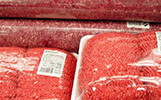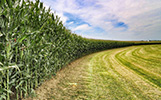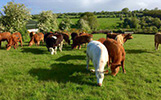| Pink Slimed: The Beef Industry Learns the Importance Of Social Media Literacy 
Kristin Runge, Wisconsin Public Radio | March 23, 2016
This is a cautionary tale about the importance of social media literacy, involving a company with a limited online profile, a hot–button issue, and a contingent of interested citizens with active social media accounts. On March 7, 2012, ABC World News Report aired the first in a series of stories on lean, finely textured beef, asserting that 70 percent of ground beef sold in United States stores contained "(pink slime) beef trimmings...once used only in dog food." What happened next caught the beef industry off guard. The editors of Meating Place, an industry magazine, described online reaction as "a social media frenzy."
Bots Insists on Shooting Zim Strays
Chronicle | March 25, 2016
The Botswana government has imposed a shoot to kill order on Zimbabwean cattle that stray across the border as a way of tightening disease control, especially Foot and Mouth Disease, which frequently breaks out along the border.
Iowa's Ag Industry Urging Farmers to Save Money While Upping Water, Soil Quality 
Jim Offner, Cedar Valley Business | March 25, 2016
Farmers are investing in two prime ingredients of their business success: water and soil. As that happens, and programs like the Iowa Water Quality Initiative and the Iowa State University–developed nutrient reduction strategy gain critical mass, one question pertinent to every farm's bottom line is beginning to replace another. Instead of wondering if they can afford to invest in cover crops or new tilling methods, farmers are beginning to wonder if they can afford not to.
Coveney Says He Has Raised Irish Concerns Over Possible Mercosur Trade Deal
Ciaran Moran, AgriLand | March 27, 2016
The Minster for Agriculture, Simon Coveney has said that he has repeatedly raised Irish concerns at EU level in relation to the potentially serious impact that a Mercosur deal would have on the Irish and EU agriculture sector and, in particular, on the beef sector. Responding to questioning on the issue in the Dail this week, he said the Commission's own analysis of the worst case scenario would see production levels drop by some 150,000t, with the producer price for beef falling by as much as 8%.
Beef Producers Can't Swallow Linking of Red Meat, Cancer
Amy Palser, Hastings Tribune | March 27, 2016
Thank goodness Nebraskans have good common sense, Diane Karr says. The Blue Hill resident, who owns a cow–calf operation with her husband, Mike, was a little concerned when the World Health Organization announced last fall that red meat "probably" caused cancer. After all, the beef cattle industry is the state's single largest industry. Nebraska ranks second in total number of cattle behind Texas, and first in number of cattle in feedlots. The WHO's announcement could have been detrimental to beef producers like the Karrs, but in the end there seemed to be little to no fallout, save for a bevy of initial media attention.
Get Ready For a Five–Year Revolution of the Northern Australian Beef Production Model
Dr. Ross Ainsworth, BEEF Central | March 29, 2016
By 2021, the Australian beef industry will be a very different creature than the one we have been used to for the last 40 years, suggests Dr Ross Ainsworth.
Beef Demand Increases, Producers Stand To Benefit
Carolyn Heneghan, FoodDive | March 28, 2016
Chicken may have overtaken beef in the past few decades as consumers took stock of health and economic concerns, but the beef industry is bouncing back. USDA data predicts that Americans will eat 54.3 pounds of red meat this year, a nearly half–pound increase over 2015. That's the first increase in red meat consumption in the U.S. since 2006.
South American Beef Exports to Rise In 2016 – Rabobank
Amy Forde, AgriLand | March 31, 2016
Exports of beef from South America are toincrease by 11% in 2016, according to the latest Rabobank Beef Quarterly. Currency values, improved access to importing countries and increased availability of beef, are all factors Rabobank has attributed to the rise. Angus Gidley–Baird, Senior Animal Protein Analyst at Rabobank said that Brazil, the largest Latin American beef producer, is expected to see reduced local consumption and gains in export access. This will lead to more exports, the Animal Protein Analyst said.
Global 'Currency War' Had a Big Impact On the World's Biggest Beef Exporters 
Sean Cummins, AgriLand | March 31, 2016
Beef exports from Brazil and Australia – two of the top three beef producers in the world– recorded a mixed performance during 2015, according to the AHDB. The existence of a global currency war had an effect on export volumes of Brazilian beef, whichdropped by 12% last year, figures from the AHDB show. The fall in Brazilian beef exports coincided with a reduction in beef production, as Brazilian farmers reduced supplies to match falling demand.
Farmers and Producers Not Ready for Big Antibiotic Changes in 2016
Maryn McKenna, The Plate | January 21, 2016
The most significant changes in U.S. food–animal production in decades are coming by the end of this year, and farmers and producers aren't prepared. That's the warning of the nonpartisan Farm Foundation, based in Oak Brook, Ill., in a report called Stewardship of Antimicrobial Drug Use in Food–Producing Animals, released Wednesday morning. The changes will make giving animals low doses of antibiotics to promote growth illegal, and new federal rules will require large–animal veterinarians to start approving antibiotic use. And a shortage of these veterinarians may make implementing the new changes even more challenging, Farm Foundation says.
Better Grassland Care Needed to Satisfy Meat Demand
Sci Dev Net | March 29, 2016
Overgrazing and poor soil management are depriving grasslands of essential nutrients such as phosphorus, a study warns. As the demand for meat and dairy grows in developing countries, grasslands need better management to produce enough animal feed such as fresh grass and hay, the researchers found. The study focuses on phosphorus, a soil nutrient that, along with nitrogen and potassium, is essential for grass growth. The researchers estimate that the amount of phosphorus added to the soil would need to rise fourfold by 2050 — for example by applying fertilisers — to grow sufficient grass on existing grassland. | |
